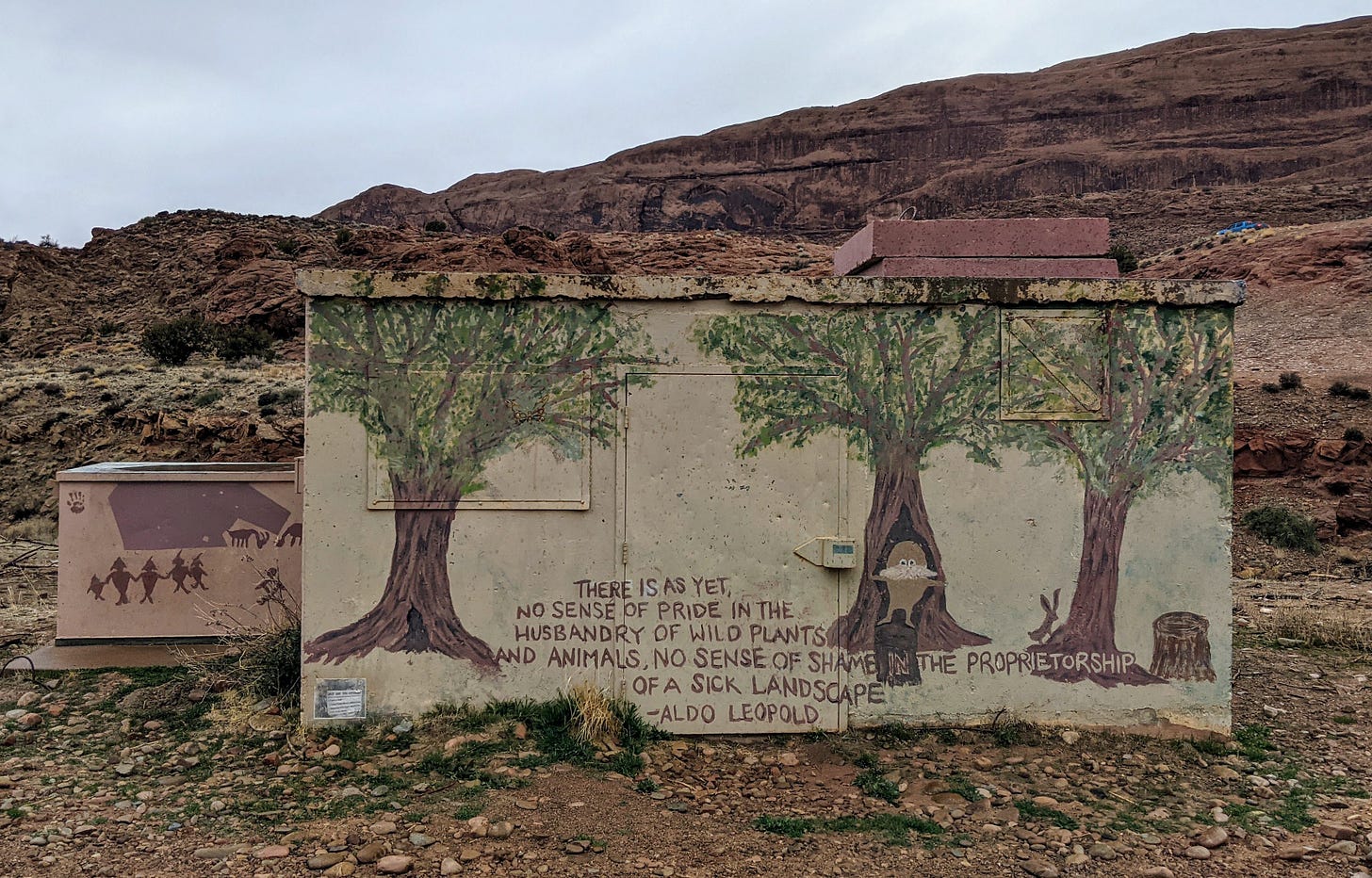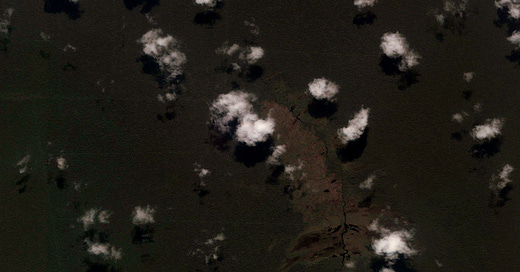Placeful is a biweekly newsletter exploring sense of place, sustainability, and the actions we can take to more deeply engage with our communities and wild spaces. Each issue covers a new topic. To learn more about the “why” behind Placeful, start here.
Any books mentioned in this issue may be found on my bookshop shelf. I may earn a commission from books purchased through these links, at no additional cost to you.
Last month in Moab, there was an incident involving a large bird and a reindeer. Not real animals of course—both were sculptures installed in 2019. However, both were also the unfortunate recipients of significant damage, and vandalism is suspected in at least one of the cases.
There was a lot of public outcry when word got out. Many sad and angry commentors took to the Moab City Police Department’s Facebook page, including one generically blaming kids and another blaming UTV tourists (though neither had proof). A reward was offered by the City of Moab, and matched by a private donor (nothing ever came of it that I am aware of).
The whole incident got me thinking a lot about the role of public art in community life. Community members’ reactions to the vandalism was emotional. Though I was less familiar with these pieces, I did think about pieces of public art that I’ve lived near over the years and how I would feel if they were harmed. The answer? Pretty darn upset.
Attachments to public art are not uncommon. Research shows that community members highly value public art, which ultimately influences their attachment to place:
According to a 2012 study by the Knight Foundation, which surveyed approximately 43,000 people in various cities, “social offerings, openness and welcome-ness” and the “aesthetics of a place — its art, parks and green spaces” ranked higher than education, safety and the local economy as a “driver of attachment.” (Parks & Recreation, Sept. 2016)
Take one drive around my home in Moab and you’ll see how our public art reflects our attachment to the area. Much of the artworks feature recognizable Moab-area geology, flora, and fauna, as well as the colors present in our everyday environment: beautiful red rocks, bright blue skies, glowing pink sunsets, and tons of contrast.
The role of public art
Public art serves many different functions, but one is fairly obvious: beautification. So much of our public art adds color and vibrancy to areas that weren’t always that way: alleyways, utility boxes, old grain elevators, those spaces where a gravel parking lot meets a windowless exterior wall.
Some communities see public art as an opportunity for economic development. People are drawn to areas with robust public art programs, and tourists seeking cultural experiences tend to spend more during their travels than tourists unconcerned with these types of experiences.
As we might expect, even city residents cherish their local public art. One survey from 2012 found that “Philadelphia residents ranked viewing public art as the second most popular activity in the city, besting hiking, jogging and biking.” And if they are out and about enjoying the vast, free art gallery in their city, they are also most likely spending money at local businesses along the way.
Activism is also a function of public art, as well as it’s more rebellious sibling street art. During the period of unrest sparked by Breonna Taylor and George Floyd’s deaths in 2020, activist-artists got to work painting beautiful memorials that also served as calls-to-action.
Sites of public and street art also serve as places where people can gather in solidarity, find community, and express their emotions. They can be also celebratory spaces, mourning spaces, motivating, playful, or instructional.
Public art can also capture the ideas of a particular time and place; sometimes reflective of the community’s values as a whole, or the concerns, ideas, or visions of a subgroup within that community. Art also, naturally, reflects the values of the artist or artists themselves, though all these individuals and groups surely influence one another to varying degrees.
For example, at the Power Dam section of the locally famous Mill Creek trail in Moab, the Lorax (or a conspicuously similar character) pairs up with our good friend Aldo Leopold:

This quote comes from the “Oregon and Utah” essay in Leopold’s classic book, A Sand County Almanac, published in 1959, wherein he writes about the unfortunate takeover of cheat grass in the area, its subsequent effect on wildlife, and the role humans (or more specifically, their herds of grazing cattle) have played in creating a “sick landscape.” He essentially asks, how are we not embarrassed about our responsibility for the destruction of land, and the effects of our actions on the plants and animals who depend on it?
This quote, and these feelings, are very much tied to conversations and disagreements over public land use in the Moab area, making this particular piece of public artwork both temporally and spacially relevant—as is most public art.
Leopold wrote that sentence from his time and place. The artist utilized it in their work, which was created in a different place and time. Over time, we reshape the story of our community while that community shapes and reshapes us.
Placemaking & public art
Nothing is so consistent in our everyday lives as the visual landscape around us (for those of us who can see). Our sense of sight is one of the strongest tools we have for connecting with place, and public art is one way that artists, businesses, city planners, and other stakeholders influence the aesthetics of our communities.
In some circles, this action is called “placemaking.” The Project for Public Spaces (PPS) has an excellent definition:
As both an overarching idea and a hands-on approach for improving a neighborhood, city, or region, placemaking inspires people to collectively reimagine and reinvent public spaces as the heart of every community. Strengthening the connection between people and the places they share, placemaking refers to a collaborative process by which we can shape our public realm in order to maximize shared value. More than just promoting better urban design, placemaking facilitates creative patterns of use, paying particular attention to the physical, cultural, and social identities that define a place and support its ongoing evolution.
Placemaking, as defined by PPS, should also be community-led, involving multiple stakeholders at every step of the planning process, as well as context specific, collaborative, inclusive, sociable, and visionary.
Each and every day, opportunities arise to (literally) design the world that we want. We can do this individually in our homes, creating or collecting art of our own. Our communities are doing this too, and at a larger and more collaborative level through landscape design, architecture, zoning, demolition, and public policy—and of course, through public art projects.
Public art does not mean inclusive art
Calling it public art assumes accessibility to the art by the broader public, which in most cases is true—except for when it is not. There are still public spaces that are unwelcoming to groups of people, such as those experiencing homelessness, as well as neighborhoods people may feel uncomfortable passing through, even if not technically off limits. Art also plays a role in gentrification, raising property values to a degree that longtime residents can no longer afford to live there, and drawing in wealthier folks through art and aesthetics that appeal to them—sometimes known as “placetaking.”
Reimagining and reinventing
Public art is one of the many ways we can engage in placemaking in our communities. Though public artworks may not reflect everyone’s experiences, it creates opportunities for engaging with each other, and engaging with our inner selves, too. It’s an important component of any well-designed city in my opinion, so long as it involves a diversity of voices in the decision-making.
Through public art, we can find more reasons to fall in love with our communitites, and express that love, too. Best of all, public art gives us a reason to be visionary—to reimagine what our communities can look like and share that vision boldly.
And if a piece of art no longer reflects our values, I guess it’s time to get out the paintbrush.
With love,
Emily
Placeful Practice
Make a trip to a public art piece in your community and spend some time with it. What values does it reflect? Who in your community shares these values? Who in your community does not share these values? Will this piece still be relevant in 5, 10, 50 years? Reflect on the piece and see what you can learn about yourself and your community in the process.
I’d love to see some photos of the public art in your communities! Tag me on Twitter; I’ve started a thread here :) You can also describe it in a comment on the Placeful website, link below!
Placeful is a biweekly email newsletter containing essays on sense of place and sustainability. Every other week I delve into a new topic, wrapping it up with an action item that will help readers foster deeper connections to the natural, cultural, built, and historic environments around them. Read more about Placeful.
To find a web version of this issue, click here. Know someone who would appreciate the topics I’m writing about? Please share! If you’d like, you can follow me on Twitter (@emily_ann_again) or Instagram (@emily.a.roberson). My inbox is always open at placeful.emily@gmail.com. And lastly, if someone forwarded this to you, subscribe below to receive future issues straight to your inbox. Thanks for reading <3










